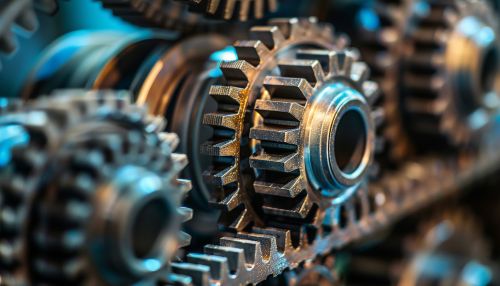Gears
Introduction
Gears are a fundamental component in a multitude of mechanical devices and systems. They are rotating pieces of machinery with teeth, or cogs, that mesh with another toothed part to transmit torque. Gears can change the speed, torque, and direction of a power source. They are used in various devices, from simple mechanical toys to complex automobile transmissions.


History of Gears
The concept of gears dates back to the ancient civilizations of the world. The earliest known examples of gears are from the 4th century BC in China, where they were used in chariots. The Greeks also utilized gears in their mechanisms, most notably in the Antikythera Mechanism, an ancient analog computer.
Types of Gears
There are several types of gears, each with their unique characteristics and applications. These include:
- Spur Gears: These are the simplest type of gear and the most commonly used. They have straight teeth and are mounted on parallel shafts.
- Helical Gears: These gears have teeth that are cut at an angle to the face of the gear. This allows for smoother and quieter operation compared to spur gears.
- Bevel Gears: These gears have teeth that are cut on an angle, allowing them to connect shafts that are not parallel.
- Worm Gears: These gears are used to transmit power at 90 degrees and where high reductions are required.
- Rack and Pinion Gears: These gears convert rotational motion into linear motion.
Gear Design
The design of gears involves a complex set of engineering principles and considerations. This includes the gear ratio, which is the relationship between the number of teeth on two gears that are meshed or connected. Other factors include the pitch (the distance between corresponding points on adjacent teeth), the module (the ratio of the pitch diameter to the number of teeth), and the pressure angle (the angle at which the teeth of a gear engage with each other).
Gear Manufacturing
The manufacturing of gears involves several steps, including cutting, broaching, hobbing, and grinding. The process used depends on the type of gear, the material it is made from, and its intended use. For example, the manufacture of a steel spur gear for use in a high-performance automobile would require different processes than a plastic gear for a toy.
Applications of Gears
Gears are used in a wide variety of applications, from small mechanical devices to large industrial machinery. Some of the most common applications include:
- Automobiles: Gears are used in the transmission to change the speed and torque from the engine to the wheels.
- Clocks: Gears are used in clocks to control the movement of the hands.
- Industrial Machinery: Gears are used in various types of machinery to transmit power and motion.
- Bicycles: Gears are used in bicycles to change the speed and difficulty of pedaling.
Future of Gears
With advancements in technology, the future of gears looks promising. Developments in materials science, such as the use of composite materials, could lead to lighter, stronger, and more efficient gears. Additionally, advancements in manufacturing processes, such as 3D printing, could revolutionize the way gears are made.
